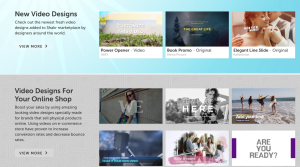We learn to write from a very young age.
At school, reading and writing is first skills we learn. It’s key to communication and important to everyday life. Social media – reading and writing. It is something we take for granted.
The ability to write well means you have a skill that will always be in demand. Being able to persuade people through writing means you could probably be a top-selling author for some self-help book; OR, you could be a copywriter.
This blog explores copywriting, what it is, and how to write better copy for promotional materials.
“Copywriting is the optimum use of language to promote or persuade.” (Albrighton, 2013)
Copywriting is the act of writing materials to be used for promotional purpose.
The text is called copy (hence the name copywriting).
The writer must determine the optimum way to communicate with the audience, such as:
the length of the copy
- structure
- tone
- choice of words
As well as being an action or process, copywriting is also the occupation of people who write copy. The Internet has brought new opportunities for copywriters. Copywriters can find work online and collaborate with people from PR, marketing and customer service.
Copywriting is about creativity.
Nobody likes to read something boring! You are going to lose the reader’s interest and attention, right? That is why a copywriter is also known as a ‘creative’ in advertising agencies. It is their responsibility to come up with copy or slogans for ad campaigns.
A copywriter must be proficient in the language they are writing in. They need to produce high-quality and grammatically correct and error-free content, reflecting the brand’s brand’s ‘voice’.
Promotional
Copywriting has promotional intent to impact the perceptions of the reader. The copy has a clear intention, meaning you want your audience to think, feel or act in a certain way after reading or listening to your message.
Copy aims to convince the reader to take action, using words to influence an outcome in the real world.
“In contrast to ‘pure’ creative writing – writing principally to entertain or provoke thought – copywriting is all about achieving a particular outcome in the real world.” (Albrighton, 2013)
Promotion is often of products and services, the brand itself, or but it could also be ideas, opinion and people such as political candidates.
Copywriters produce print advertising, website and landing pages, social media content, emails, telephone scripts, radio ads, sales letters, blog posts, case studies and other marketing communications.
A sales team contacts customer one at a time; a copywriter uses one piece of content that reaches many potential customers. Hence the importance to get it right!
Copywriting is the glue that ties a marketing strategy together.
“Whatever medium you end up writing for, you are creating something that takes a brand truth and makes a reader or viewer or passer-by care about it.” (Iezzi, 2010)
Understand what you are selling
A deep understanding of precisely what you are selling is the starting point for writing excellent copy. If you write copy for a living, knowing the products or services as intimately as the company producing them, can be overlooked.
A good copywriter will research their topic to identify the most compelling and straightforward sales pitch.
Write down everything about your topic from description to features and benefits. You will not use everything, but you may uncover something you haven’t thought of yet.
Brainstorm the following:
- What is the product/service/brand/thing??—?Describe it in simple terms with two to three sentences. This sentence is your elevator pitch?—?as if you were describing a product to a customer.
- What makes it unique or special??—?Communicate your product’s features make it different from the alternatives out there. What does your product offer that others don’t? Your positioning and unique selling proposition (USP) come in here.
- What benefits will appeal most to your audience? People always want to know what is in it for them. Copywriters must be familiar with the benefits of what they are writing about to their audience. Customers often care more about the usefulness of features rather than the features themselves.
- Does it alleviate pain? People typically buy for one of two reasons. Either to increase pleasure or to minimise pain. For some products or services (or politicians), talking about a shared pain and eliminating it by your brand can be more effective than focusing on the pleasure provided. You can test both approaches in the different copy to test what works best.
“The copywriter’s goal is to communicate the strengths, advantages or benefits of whatever they are promoting so their audience buys into them – whether literally or metaphorically.” (Albrighton, 2013)
Copywriting StrategyWriting is subjective. That is part of what makes writing so engaging. Give ten people the same topic to write an article about it, and all ten will be different, even with the same brief.
Even though excellent writing can be vastly different, writers often use a similar process. Use these tips to help create a more engaging copy.
Capture attention!
The first thing a piece of copy needs to do is capture the attention of the reader. Otherwise, people might only read a couple of sentences and decide it is not worth their time.
Good marketing copy uses an idea that is interesting and relevant to the audience. The brand plays a role that engages the readers’ attention. This idea needs to be at the start of the copy.
Through creating a line between two things, this generates conversation through the tension. Try and create tension, as tension attracts attention. Then, position the brand to provide a solution. This solution should be appealing to the reader if they are a member of the target audience.
“At its root, your challenge is to make a connection with a human being.” (Iezzi, 2010)

Connect with the reader
Write about topics that human beings care about. Try to provoke an emotional response. Emotions are not just for novels or TV commercials. Any time we have engaged somebody in reading, we want them to feel something.
When writing copy, consider whether what you are creating adds something of value to the reader; whether it is useful, entertaining, humorous or has a ‘feel-good’ factor.
You can position the offer in your copy in different ways to elicit this response.
For example, by reducing the interest rate on a mortgage, this could create relief as there is more left of money to pay bills or save more for that holiday. Another example is copy focusing on feeling safer and protecting the family by purchasing a car with a higher safety rating.
Storytelling
Storytelling feels real, immediate and personal. Good copy should tell the narrative behind a brand to capture the moments and experiences shared by humans. A human component to a brand increases consumer trust, as it helps the brand seem more relatable.
Tell a compelling story while convincing the audience of the need for what you are promoting. Create a distinct beginning, middle and end to your story; so, it is easy to follow, understand, and memorable. Case studies are a form of content typical in B2B, involving very detailed storytelling.
“Generally, both pictures and headlines could lead the consumers to read the body copy. In fact, pictures could send a particular message faster than the words do.” (Zulkifly & Firdaus, 2014)
Imagery
Often, relevant visual components compliment copy. Just like the headline, the visuals attract the reader to read the rest of the text. There should be synergy between the headline and imagery; the visuals influencing the context and presentation of the content.
Examples of visuals are the chosen typography, overall design and contrasting colours, any imagery such as photography, illustration or infographics.
Tone of voice
The tone used by a copywriter dictates the brand’s ‘personality’. What you say and how you say it. This communication style should be consistent, so every media piece feels like it is coming from a single source. Having a single voice will seem more authentic, which means consumers will find you more trustworthy.
It is reassuring when a person says the same things and does the same things consistently – and it is the same with a brand.
Assign a few personality traits to your brand, to come out in the copy. However, not too many and keep it simple, being too cute or witty can complicate your message.
Structure
Learning how to structure writing is best done through writing and then more writing. Being a good writer comes from the experience of organising and shaping many different types of material into pieces of content.
Some writers use a templated structure to their copy. Others write by first getting their ideas down on ‘paper’ and then getting a sense for what pattern or format emerges.
Most writers do not get it right first, and tinkering with their writing structure is ongoing until completion. As the text evolves, it starts to turn into a tidier format.
Do not try to format copy like a traditional document, writing in long paragraphs. Aim for one point per sentence and one theme or idea per section, about 3 or 4 sentences long. They could be even less. Every new idea should be on a separate line.
This format is suitable for print and web copy because it’s simple and easy for the reader to follow.
Ways to structure copy
There are many ways to structure a piece of writing.
Some popular approaches are:
Benefits
Since communicating benefits are at the heart of good copywriting, using them to guide your copy structure should mean your copy will be persuasive.
Promise something of value to the reader.
How can you meet their needs?
If your product or service solves a problem, make sure people know it. Structure your writing around this, with each section explaining how you deliver a particular benefit.
“Copywriting that focuses on benefits is more persuasive, more compelling and sells better.” (Albrighton, 2013)
Features
At times, you might be writing for a technically educated audience, which is when structuring copy to highlight features could be the best approach.
Problem and solution
the copy begins by describing a problem that the audience will relate to, before explaining how the business provides a solution (ultimately, most copy should have a component of this format.
Numbered list
Break down the points you want to make in a numbered format can add a sense of organisation, even if your writing is not that focused. It is a popular way to format writing for blogs; for example, “10 reasons why 50 weeks of marketing is the best way to spend $ 100.”
“Although most copywriters will tell you they find writing headlines the hardest part of any job, sometimes they just seem to arrive out of the ether.” (Maslen, 2010)
Headline
The headline is a writer’s first and most significant chance to attract a captive audience.
It is a promise of value and benefit to the reader from reading it. The copywriter must create intrigue to capture attention, generate interest, and encourage readers to read on or buy into the message.
Be careful not to give empty promises or use a clickbait title. We want to build rapport with readers to enhance our credibility. Not leave the reader feeling empty-handed.
The headline also helps set the tone for the following copy, such as humour, business-like or informative. It establishes the writing piece’s theme and positions the subject for the reader, allowing them to decide if it is relevant to keep reading.
Headline text should be larger than the body, but more than twice the size and title can seem like its shouting. Likewise, for the same reason, do not use ALL CAPS, making it harder to read quickly. It would be best if you also did not use full stops at the end of your headlines.
An absence of a full stop implying the sentence hasn’t finished yet, so the reader keeps reading till they find one.
Early on in writing, do not worry about perfecting headings. At this point, you put them where they make sense to you at the moment. Headings often are not finished until the copy is ready for publishing.
“A piece of copy stands or falls by its headline. The headline is like the doorway into the room you’ve created with the rest of your text. If people don’t walk through the door, they’ll never see what’s inside the room.” (Albrighton, 2013)
Call to action
Perhaps the second most important piece of information after the headline is the call to action.
A call to action is a short piece of text (usually one or two sentences) in any advertisement or marketing communication, encouraging the reader to take a particular course of action. For example, to buy, donate, click here, or contact us.
A call to action guides the audience towards a real-world activity, encouraging the audience to move onto the ‘doing’ phase. We do not want readers to turn the page, or close the tab and check their email as we lose them.
The desired customer response for the call to action should be clear, specific and straightforward.
In summary, copywriting is the act of writing materials to be used for promotional purpose.
Comprising of components such as the length of the copy, structure and choice of words, the writer determine the optimum way to communicate with the audience.
This article has covered key components to help you improve your copywriting.
Thank you for reading.
Business & Finance Articles on Business 2 Community
(18)





